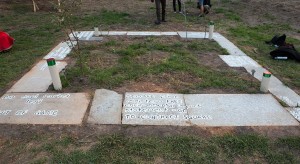part 2
Documentation of scripted performance Solastalgia involving coalmining impacted community members, their advocates and artists at a multi-screen train carriage, Cementa_15 Contemporary Arts Festival, Kandos 2015. The Irish Potato Genocide and Australia’s neo-extractivism is mashed up with Ray Bradbury’s Fahrenheit 451 to add a capitalist crisis to our social and political vacuum.
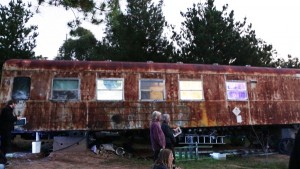 Our event was within the political territories and earshot of State and local government representatives whose jurisdictions include Wollar, and whose funding programs supported the event. The attention-grabbing platform of Cementa_15 in April 2015 brought over 2000 people to the region for the weekend, and around 100 people attended our event. As a curated action providing momentum for Bev’s work for the Wollar community, the work contextualises the community roadkill stituation within the broader political, social and economic issues, and houses the counter-culture activity in a trajectory of resistance, both real and imagined.
Our event was within the political territories and earshot of State and local government representatives whose jurisdictions include Wollar, and whose funding programs supported the event. The attention-grabbing platform of Cementa_15 in April 2015 brought over 2000 people to the region for the weekend, and around 100 people attended our event. As a curated action providing momentum for Bev’s work for the Wollar community, the work contextualises the community roadkill stituation within the broader political, social and economic issues, and houses the counter-culture activity in a trajectory of resistance, both real and imagined.
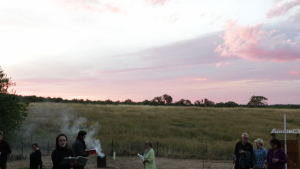 My train carriage is hidden in the pines at Clandulla, referencing the place where those in the resistance movement fled from the government to take up the role of book custodians in Ray Bradbury’s Fahrenheit 451. Performing books drawn from the arts community and two advocates for the Wollar community (one being Bev), recited key paragraphs from selected books as a scripted performance.
My train carriage is hidden in the pines at Clandulla, referencing the place where those in the resistance movement fled from the government to take up the role of book custodians in Ray Bradbury’s Fahrenheit 451. Performing books drawn from the arts community and two advocates for the Wollar community (one being Bev), recited key paragraphs from selected books as a scripted performance.
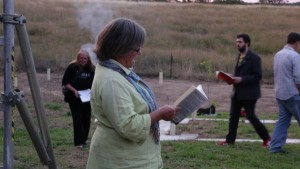 A multi-screen installation projected through the train’s doorway and windows included key scenes from Francois Truffaut’s filmic version of Fahrenheit 451 as well as a television studio event where a man in a mining excavator with pincer undresses a woman piece by piece of clothing, to the delighted cheers and gasps of the audience.
A multi-screen installation projected through the train’s doorway and windows included key scenes from Francois Truffaut’s filmic version of Fahrenheit 451 as well as a television studio event where a man in a mining excavator with pincer undresses a woman piece by piece of clothing, to the delighted cheers and gasps of the audience.
A screen inside the carriage shows Wollar representatives speaking about their solastalgic experiences, particularly the deliberate decimation of their community.
The reference to early use of mono-agriculture and the enclosure as part of early capitalist expansion as part of the Irish Potato Genocide is matched with what is being rolled out with increasing austerity onto the Wollar community.
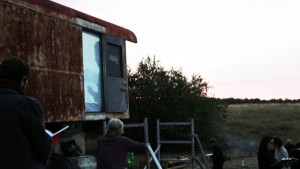 The Irish event is also important in the way that it continues to impact on the general apathy of Australians, particularly their general passive acceptance of atrocities where the social sphere is viewed as an epiphenomenon of the economy. In keeping with the way that the Irish were forced to eat only potatoes whilst growing a variety of crops destined for export, catering at the event included enclosure delights of cheese potato and spud brew.
The Irish event is also important in the way that it continues to impact on the general apathy of Australians, particularly their general passive acceptance of atrocities where the social sphere is viewed as an epiphenomenon of the economy. In keeping with the way that the Irish were forced to eat only potatoes whilst growing a variety of crops destined for export, catering at the event included enclosure delights of cheese potato and spud brew.
The text montage of the performance begins with a poem by activist for women’s rights and for revolution in Ireland Jane Wilde, mother of Oscar:
THE FAMINE YEAR
Weary men, what reap ye? – Golden corn for the stranger.
What sow we? – Human cor(p)ses that wait for the avenger.
Fainting forms, hunger-stricken, what see you in the offing?
Stately ships to bear our food away, amid the stranger’s scoffing.
They’re a proud array of soldiers – what do they round your door?
They guard our masters’ granaries from the thin hands of the poor.
Australian academic and artist Anna Gibbs writes in her article about the event “A timeline of headlines from the Mudgee Guardian newspaper provides a spine for the details about the development of coalmining around Wollar amidst excerpts from other sources such as Sharyn Munro’s Rich Land, Wasteland – How coal is killing Australia, Ray Bradbury’s Fahrenheit 451, for example: ‘If you don’t want a man unhappy politically, don’t give him two sides to a question to worry him; give him one. Better yet, give him none’. This is followed up with quotations from German romantic poet Heinrich Heine’s 1823 work, A Tragedy: ‘It is there, where they burn books, that eventually they burn people’ and German-Jewish philosopher Hannah Arendt’s On Revolution: ‘Collective responsibility involves something I have not done, and the reason for my responsibility must be my membership in a group, which no voluntary act of mine can dissolve’. Then Bradbury again: ‘Somewhere the saving and putting away had to begin again and someone had to do the saving and keeping, one way or another, in books, in records, in people’s heads, any way at all so long as it was safe, free from moths, silverfish, rust and dry rot, and men with matches. The world was full of burning of all types and sizes’.”(4)
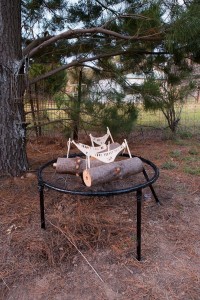 As a way to draw the program to an end, Tony Abbott yule logs
As a way to draw the program to an end, Tony Abbott yule logs  (anointed with Clandulla wattle, wine and oil) were offered to audience members to participate in a cleansing pagan ritual. In the closing section, performing books and Wollar residents moved as a block into a human-scale version of the inner political ring of the neo-extractivist coalmining game. This was made using reclaimed painted granite pieces arranged in a square to reference the shrinking and overcomplicated Wollar commons.
(anointed with Clandulla wattle, wine and oil) were offered to audience members to participate in a cleansing pagan ritual. In the closing section, performing books and Wollar residents moved as a block into a human-scale version of the inner political ring of the neo-extractivist coalmining game. This was made using reclaimed painted granite pieces arranged in a square to reference the shrinking and overcomplicated Wollar commons.
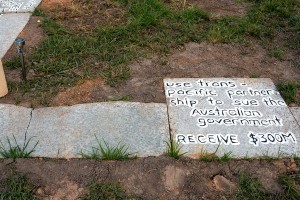 Inside the train the prototype board game is
Inside the train the prototype board game is 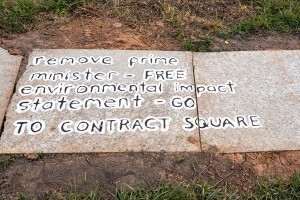 exhibited with some of the newspaper articles used for the performance. A television monitor plays the news broadcast shown to Fahrenheit 451’s protagonist Montag in the final section of the film inside the hideout train carriage. This is of his fabricated pursuit and murder. For the performance this scene is intercut with comments from Wollar residents to provide an endless loop of hunting style pursuits.
exhibited with some of the newspaper articles used for the performance. A television monitor plays the news broadcast shown to Fahrenheit 451’s protagonist Montag in the final section of the film inside the hideout train carriage. This is of his fabricated pursuit and murder. For the performance this scene is intercut with comments from Wollar residents to provide an endless loop of hunting style pursuits.
The train’s rust continues to be removed using potatoes that fix a protective black coating. This design draws from Robert Motherwell’s work and is titled Elegy for an Australian republic – after Motherwell, and reflects on the deleterious impacts of ongoing missed opportunities that could have provided turning points for a more autonomous cultural, political and economic Australia. 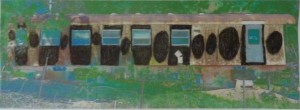 This exploration of steel and potatoes as British and the Irish, can be considered as a type of counter-culture resistance like in the power inversions of the game Rock-Paper-Scissors, where folk remedy as performance chemistry explores novel devices and processes to re-purpose behaviours for the degrowth movement.
This exploration of steel and potatoes as British and the Irish, can be considered as a type of counter-culture resistance like in the power inversions of the game Rock-Paper-Scissors, where folk remedy as performance chemistry explores novel devices and processes to re-purpose behaviours for the degrowth movement.
This citizen science playfully engages with expanded painting in metallurgical ecological-art processes pioneered by American-Chinese artist Mel Chin. Chin’s sculptural manipulation of materials carved away a block of pollution just as this work sculpts rust. Mashed potato sack packs with wrap, deemed suitable by a train restoration enthusiast qualified chemist, are strengthening the steel’s oxalate layer protective coating whilst turning it black. The work embraces anti-capitalistic efforts to encourage less resource intensive means to find solutions to problems by relearning crafts and finding ways to apply these domestic skills at other levels. Applied at a variety of scales, this idea with others can re-inject labour back into industry as one step in the recovery of the manufacturing sector of the economy. Also, this labour-intensive slow art, which takes a sideways glance at “heavy metal” sculpture, provides what Mexican-American philosopher Manuel de Landa argues our bodies are needing, which have been deskilled after two centuries of military routinisation.[5]
part 1
Solastalgia was coined by the Australian philosopher Glenn Albrecht in 2003 to describe a form of psychic or existential distress caused by environmental change, such as mining or climate change.(1) As opposed to nostalgia, the melancholia or distress experienced by individuals when separated from a loved home such as homesickness, solastalgia is the distress that is produced by environmental change impacting on people while they are directly connected to their home environment. A sense of powerlessness or lack of control over the unfolding change process exacerbates the distress, which has been conceptualised as mental illness by Seamus Mac Suibhne.(2)
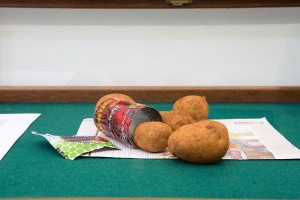 Vitrine with game, potatoes, documents, concentration camp bark scrapers to provide means of sustenance. SCA Galleries, Sydney 2014
Vitrine with game, potatoes, documents, concentration camp bark scrapers to provide means of sustenance. SCA Galleries, Sydney 2014
Advertising has been used by government using the techniques identified by Edward Bernays to create a situation where the general population of liberal democratic countries embrace neoliberal governmentality and globalisation as necessary processes of ‘progress’, even though this entails growing prevalence of solastalgia and further threats to the biosphere. This work shows a trajectory to move from this space to one of empowerment through engaging with the games of government and action, and more radical action.
Curatorial strategies lead the eye from right to left in this work. In the vitrine the potatoes are placed between concentration camp food scrapers that have been updated from the types of bare tins in the collection of the Berlin Holocaust Museum to include logos and language of Asia given Australia is being bought by this geo-political power leader in the region.
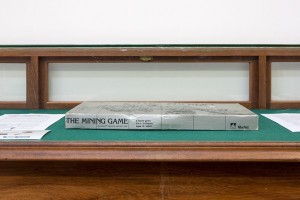 Ongoing engagement with governmental processes such as initiating and participating in public inquiries as part of coalmining expansion approval processes is important when concerted attempts are made by corporations and governments to present that communities, such as Wollar, no longer exist. The vitrine includes an unopened 1974 version of the Murfett Mining Game that has been updated in part 2 of Solastalgia to represent the neoliberalised and globalised terrain that we are now living in, which has brought about neo-extractivism.
Ongoing engagement with governmental processes such as initiating and participating in public inquiries as part of coalmining expansion approval processes is important when concerted attempts are made by corporations and governments to present that communities, such as Wollar, no longer exist. The vitrine includes an unopened 1974 version of the Murfett Mining Game that has been updated in part 2 of Solastalgia to represent the neoliberalised and globalised terrain that we are now living in, which has brought about neo-extractivism.
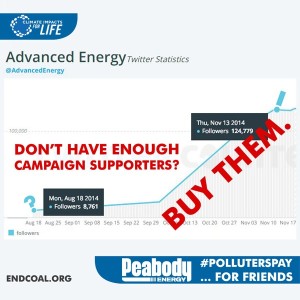 Campaigns are needed to debunk the lies perpetrated by the mining corporations and supported by the mainstream media and governments, which includes lies about community support for their activity, and the way in which they are buying out properties and businesses, reducing services and creating division within communities.
Campaigns are needed to debunk the lies perpetrated by the mining corporations and supported by the mainstream media and governments, which includes lies about community support for their activity, and the way in which they are buying out properties and businesses, reducing services and creating division within communities. 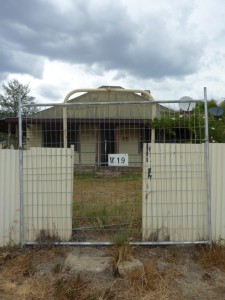 This also involves government activity at all three levels prioritising the interests of the mining corporations over that of the community, such as tax incentives at a federal level, cheap state managed land purchases and quick approval processes, as well as local government prioritising maintenance and upgrade of those roads used for mining corporations.
This also involves government activity at all three levels prioritising the interests of the mining corporations over that of the community, such as tax incentives at a federal level, cheap state managed land purchases and quick approval processes, as well as local government prioritising maintenance and upgrade of those roads used for mining corporations.
The Public Assessment Commission meeting initiated through the coordinating activity of Bev Smiles relating to the expansion proposed by the Peabody-owned Wilpinjong Coal Mine in Mudgee on 13 November 2014, successfully delayed planning and development to impact on Peabody’s vulnerable financial situation. On behalf of the Nature Conservation Council I raised the following points:
Proponent review of draft conditions The Report identifies that Peabody has viewed and accepted the proposed conditions[5] for modification 6. NCC strongly objects to the fact that the proponent is given the opportunity to review the key regulatory document which provides the legal basis of approval for mining operations. The community is not afforded the same level of consideration and yet their properties can be listed within the conditions. This is an indication of the imbalance in the NSW planning system that favours the mining industry above other land uses and social impacts. The Planning Assessment Commission is the only independent umpire left in the system. The people of NSW now rely on the Commission to make balanced decisions on mining proposals.
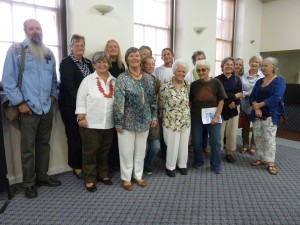 Industrial Noise Policy NCC considers that the Industrial Noise Policy is a very biased policy that has caused immense community disruption throughout the state’s coalfield areas. The noise impacts on the Wollar community are an important example of how the planning system works against the integrity of remote rural communities. It is very disturbing to find the Report supporting the aggressive acquisition policy of Peabody Energy that has virtually decimated a thriving rural community. The issue of low frequency noise impacts has not been adequately considered, assessed, monitored or reported for open cut coal mine operations. NCC notes that the NSW Government has taken on board the concerns about low frequency noise generated from wind turbines. The same level of concern has not been demonstrated in relation to the 24 hour, 7 days per week operation of a very large fleet of diesel engines including 15 D11 bulldozers, excavators, haul trucks and auxiliary vehicles such as water trucks.
Industrial Noise Policy NCC considers that the Industrial Noise Policy is a very biased policy that has caused immense community disruption throughout the state’s coalfield areas. The noise impacts on the Wollar community are an important example of how the planning system works against the integrity of remote rural communities. It is very disturbing to find the Report supporting the aggressive acquisition policy of Peabody Energy that has virtually decimated a thriving rural community. The issue of low frequency noise impacts has not been adequately considered, assessed, monitored or reported for open cut coal mine operations. NCC notes that the NSW Government has taken on board the concerns about low frequency noise generated from wind turbines. The same level of concern has not been demonstrated in relation to the 24 hour, 7 days per week operation of a very large fleet of diesel engines including 15 D11 bulldozers, excavators, haul trucks and auxiliary vehicles such as water trucks.
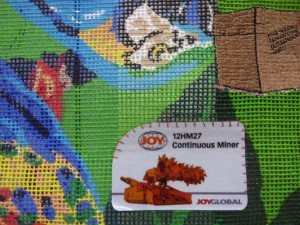 Spontaneous Combustion NCC acknowledges that the Report and recommended conditions of approval have required more stringent management of coal stockpiles and waste emplacements in a dedicated Spontaneous Combustion Management Plan. However, the company has identified that there will be further periodic and short term events associated with the remediation strategy until the end of 2015. NCC emphasises that these events should be managed so that no offensive odours leave the site as required by the approved conditions.
Spontaneous Combustion NCC acknowledges that the Report and recommended conditions of approval have required more stringent management of coal stockpiles and waste emplacements in a dedicated Spontaneous Combustion Management Plan. However, the company has identified that there will be further periodic and short term events associated with the remediation strategy until the end of 2015. NCC emphasises that these events should be managed so that no offensive odours leave the site as required by the approved conditions.
Economic justification Finally NCC wishes to note the recent Fifth Assessment Report from the International Panel on Climate Change recommends that greenhouse gas emissions must decrease over the next few decades if we are to avoid catastrophic climate change impacts. The economic, social and environmental impacts of a heating planet will far outweigh any short term gain of royalties, jobs and profits from coal mining.
The Response to Submissions admits that Modification 6 will create a very short term benefit to the company and regional economy[6]. There will be no new jobs created by this approval. The increased production rate will peak within 2 years and then cause a halving of the job numbers, royalties and regional flow ons. The Report maintains that the modification application is aimed at strengthening the mine’s economic future[7]. However, it does not reflect that this will only be achieved over a 2 year period.
In early 2014, preliminary investigation for this project included a mural design called Famine for Studio Ra in Rome, the ideas emanating from my interest in exploring my roots as a Murphy-Brown from the potato-famine diaspora. 
Arts NSW funding has been provided through the Kandos Projects residency program. Other generous assistance has been provided by Denise Murphy-Brown, Jasmine Payget and Laurie Strathdee.
References
1. G. Albrecht, Solastalgia, a new concept in human health and identity, Philosophy Activism Nature 3:41-44 (2005).
2. Albrecht, G., Sartore, G-M., Connor, L., Higginbotham, N., Freeman, S., Kelly, B., Stain, H., Tonna, A., & Pollard, G. (2007). “Solastalgia: the distress caused by environmental change”. Australasian Psychiatry 15 (1): S95–S98. doi:10.1080/10398560701701288.
3. Mac Suibhne, S. (2009). “What makes “a new mental illness”?: The cases of solastalgia and hubris syndrome”. Cosmos and History 5 (2): 210–225.
4. Anna Gibbs, ‘Solastalgia’ at Cementa Southerly, April 2015
(1) Gilles Deleuze and Félix Guattari, A Thousand Plateaus, University of Minnesota Press, 1980, p. 403
5. http://www.egs.edu/faculty/manuel-de-landa/articles/the-machinic-phylum/
6. Planning and Environment Assessment Report, 10.
7. Response to Submissions, 34.
8. Planning and Environment Assessment Report, 9.
